The King of Fighters Love Letter: KOF 95
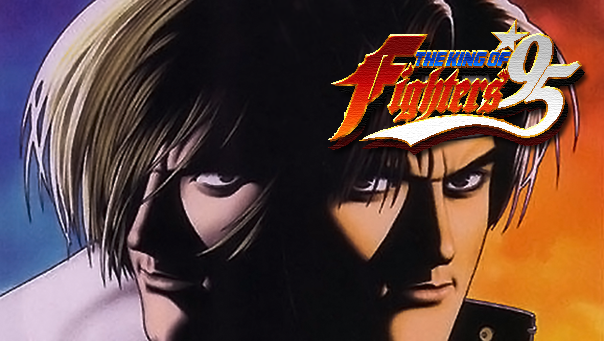
Welcome back to the King of Fighters Love Letter. With King of Fighters XIII just being announced I intend to help further blossom any enthusiasm you may have for the King of Fighters series by offering you the story that few people have successfully explained. Rest assured, this series isn’t easy to make. To be an American SNK fan kind of sucks. To this day SNK’s a relatively small company, and their efforts to localize the series were mildly effective at best until recently. Back in the day they wasn’t known for having good translators. In fact Samurai Showdown II was pretty famous for its Engrish. To this day the poor translations aren’t the issue so much as the fact that actual story info is so hard to come across. In Japan the King of Fighters series is backed up by a variety of media outside the games, here we basically rely on table scrapings.
This series was actually created through extremely ghetto means. It relies on old instruction manual transcripts, information contained within character profiles, the events and dialog within SNK’s games, whatever information SNK is willing to release on their websites, and occasionally an unofficially translated piece of media such as the King of Fighters: Kyo comic book. Every scrap of information has been put together and cross examined to ensure the most accurate story guide possible. In short: I’m tired of people having to resort to Wikipedia-type methods where there’s no guarantee anyone did real research.
Some of you are probably wondering why I even care about the story behind the series considering how much work it’s been for me to figure out the King of Fighters storyline. Let it be known that I was willing to go through this trouble simply because I love the characters and the games. It’s not necessarily the plot itself that draws peoples’ interest; it’s simply the fact that the plot presents us more information about these characters that we fans have become attached to. King of Fighters has almost always been about the cast. The series must easily have a total roster of over 100 characters. This is part of why the recent “No Mai, no Buy” slogan was insane. Even when an individual KoF game can contain 40 characters that’s only about enough for a third of the total roster. Eventually your favorite character has to sit on the bench while someone more relevant to the plot appears. Consider that there are many other characters many other people would have liked to see. You Mai fans got what you wanted with KOF XIII on its way so you better actually use her and not just look at her.

Now that we’ve established the existing backstory behind the series, we’re almost ready to begin. It’s time to discuss a new element the King of Fighters series adds to the SNK universe: Mythology. Rest assured that my own knowledge of Japan’s native religion Shinto is sparse. I’ve at least managed to research enough to offer some small insights behind the KOF series. Various King of Fighters characters have supernatural abilities. Most of the older characters have abilities inspired by martial arts anime. Kyo Kusanagi was the start of a new trend where characters would have mythical abilities. His mysterious command of flame appears to be rooted in several legends.
Most people are familiar with Greek Mythology and how it often chronicles the stories of various Gods and supernatural figures. Everyone in the West knows about Zeus and Hercules. Such stories are an ancient trend and Japan is among the nations which have legendary tales woven into their old religion. In Japanese myth a very famous figure is the Orochi. The Orochi was a powerful eight headed serpent that would demand the sacrifice of young maidens to sate his hunger. One elderly couple in particular had lost seven of its eight daughters to the Orochi before Susanoo appeared: The Shinto God of the Sea. Susanoo tricked the Orochi into getting drunk off Sake and slew it, later finding a magnificent sword in the serpent’s corpse. To help settle one of Susanoo’s disputes it was offered to Amaterasu the Shinto Goddess of the Sun. Initially this sword was dubbed Ama-no-Murakumo-no-Tsurugi; otherwise translated as “Sword of the Gathering Clouds of Heaven.”
The sword changed hands until it was given to a young prince named Yamato Takeru. Takeru had slain his elder brother for reasons I do not know. His father the King however came to fear Takeru and sent him on many seemingly impossible battles in far off lands; wishing to ensure that the Prince would never return alive. His aunt took pity on Takeru and gave him the Sword of the Gathering Clouds of Heaven in order to protect him against his father’s plans. The sword both saved the prince’s life and revealed its true nature soon after being given to him. Some time later a warlord had trapped Yamato in an open plain of high growing grass and set fire to the field. Takeru was surrounding on all sides by flames and did not have his horse to help him escape. In desperation Yamato attempted to cut his way through the grass using the Sword of the Gathering Clouds of Heaven and discovered the sword could control wind. As he swung the sword strong gales would fly in the direction of his strike. Prince Takeru cut down the grass surrounded him while simultaneously redirecting the flames to his enemies.
After this battle the sword was renamed the Kusanagi, otherwise translated as “The Grass Cutting Sword.” The sword appears frequently in Shinto myth and is even claimed in some instances to be a real artifact. It’s said that the sword is still hidden in secret at a shrine but there are also several legends claiming the blade has been lost forever and that a mere replica was made in its place. Though the Grass Cutting Sword is actually known to control wind, Yamato Takeru’s use of the sword to manipulate fire is very likely the inspiration for Kyo Kusanagi’s own ability to both create and control flames.
[youtube width=”604″ height=”250″]http://www.youtube.com/watch?v=hUqAe-0xiU4[/youtube]
And now we are finally to King of Fighters 1995, the true beginning of the Orochi Saga. Storywise almost nothing really advanced in the original King of Fighters. All it really did was establish a setting for future tournaments to take place. There’s a good chance SNK never really expected it to go anywhere. Because the game has nearly the exact same cast and a very similar premise you could easily consider KOF 95 a reboot that provides a little more plot this time around.
Revamp or not King of Fighters 95 is a significant improvement. For the time KOF 94 had greatly detailed 2D graphics that were somewhat suffering in the animation department. In lieu of this some characters got total graphical overhauls. The amount of visual improvement was sometimes subtle but it really made the game feel ahead of its time. The game actually played more smoothly as well, but it still hasn’t aged too well. Aside from refinements there was also one serious change to gameplay that would influence future games: Team Edit. The concept for using teams in 94 was very creative, but not flexible. You HAD to choose from predetermined teams. Now you could construct a set of any three characters to play with. You wouldn’t get anything other than a generic ending doing this in single player, but King of Fighters would not be the same if you couldn’t construct your own team. Story be damned; this was a boon for the multiplayer.
It all came down to refinement in KOF 95. Characters created specifically for 1994 were also allowed some time to become more distinct. Characters like Ralf and Clark who were initially so similar gained some of their own unique moves. Personalities developed too. Kensou gained his cocky attitude and trademark penchant for meat buns, helping to give him some flair after SNK admitted to rushing out his design compared to Athena. The changes are subtle in 95, but all of the refinements really did add up.

The premise is that once again fighters around the world have received invitations for a King of Fighters tournament. Once more the invitation letters are signed with a mysterious “R,” thus hinting that Rugal had somehow managed to survive the destruction of the Black Noah. Each team’s motivation to enter King of Fighters 94 is largely identical: Ryo continues to be protective of his little sister Yuri and is thankful that she’s left on an overseas trip just before his and Robert’s King of Fighters invitations arrive. While the Art of Fighting team bands together like last time, Yuri has started a new trend by sneaking off. She’d already received her invitation and made it appear as if she were just going on vacation. In reality she was already on her way to England again to gather up her team mates. The Ikari Team is formed to hunt down Rugal and ensure his neutralization on another request by Interpol. The Ikari team is even certain if Rugal is really alive or not. The Fatal Fury team is whipped into a frenzy after receiving a letter from Geese Howard and they join once more out of curiosity as to just what is behind the King of Fighters tournament.
One of the more offbeat developments involves Kim Kaphwan’s team. Choi and Chang present Kim with the invitation letter in hopes that Rugal had really survived the last King of Fighters tournament. Their plan to escape Kim’s abusive rehabilitation is to get on Rugal’s good side. Even if they’re goofy and hard to take seriously Choi and Chang remain criminals. Next there are two teams that are most aware of the underlying events behind the tournament. Kyo Kusanagi has just returned to Japan after training overseas. After meeting up with Benimaru and Goro, Kyo was attacked by one of Rugal’s secretaries: The very one who had led them to the Black Noah via escort. The Japan Team was personally handed an invitation leaving little doubt as to Rugal’s survival. The Psycho Soldiers Team had likewise noticed the presence of someone with an evil energy leaving them an invitation. Athena and Kensou had never been able to sense evil before then, but Chin recognized it and pinned down Rugal as being involved.
As I said, the game is nearly identical in terms of cast. The new characters we’re getting are the Rival Team whom directly replace the USA Sports Team from 1994. If the rumors about the USA Team having their invitations stolen are true it would have to have been the Rival Team. Considering the actual members of the Rival Team are pretty shady; I wouldn’t be surprised in the least. As always characters will be introduced chronologically based on when they first appeared in the SNK universe.
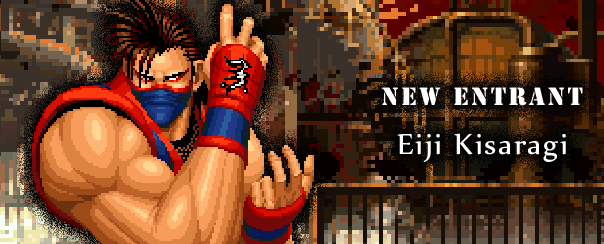
Hailing from his debut in Art of Fighting 2; Eiji is a ninja from the Kisaragi clan. His Kisaragi Ninjutsu style puts an emphasis on knives, however he sparsely uses them himself. The Kisaragi are the sworn rivals of the Sakazaki family and their Kyokugen martial arts style. As the Kyokugen style only began with Takuma Sakazaki this rivalry is not likely to be especially old. The rivalry’s origin likely involves Takuma’s fighting exploits in Japan during his youth. Eiji carries on the grudge of the Kisaragi School against the Kyokugen School. Though he dislikes every Kyokugen practitioner he seems to specifically view Ryo Sakazaki as his rival. Not very much is known about Eiji. He doesn’t appear to be set on killing any of the Kyokugen practitioners so much as proving his superiority to them.
Compared to the other members of the Rival Team Eiji doesn’t have a lot of history. In the American version of Art of Fighting 2 it’s implied that Eiji is in love with fellow ninja Mai Shiranui from the Fatal Fury series, but this was only in the English version of the game. Since then there’s been no real followup and likely the translation staff merely made this up to spice up the game. Art of Fighting 2 takes place nearly a decade before Fatal Fury. If Eiji actually did have a crush on Mai Shiranui at such a time he would be quite the ninja pedophile. It’s implied through the Last Blade series that Eiji is a descendant to the character Zantetsu, in turn suggesting that Eiji’s family and style have existed for hundreds of years.
Later on in Art of Fighting 3 we learn Eiji has an association with someone named Jin Fu-Ha. Jin’s exact relation to Eiji is unknown, but the speculation is that he was a student of Eiji’s. Jin Fu-Ha is preparing himself for the day he exacts revenge upon Eiji; once more the details are never explained. Art of Fighting 3 only takes place about a year after Art of Fighting 2 so it’s been a pretty long time since Jin Fu-Ha was introduced in the timeline. The Art of Fighting series hasn’t seen another entry since the third game and its quite possible this story arc involving Eiji and Jin will never see its conclusion. In all other forms of media that Eiji appears in he is portrayed as a rather light hearted character. Eiji Kisaragi is summoned by Billy Kane to participate in the King of Fighters 95 tournament. After a brief skirmish with Billy for summoning him he jumps on the chance to enter a fight with his sworn enemies of the Kyokugen school.
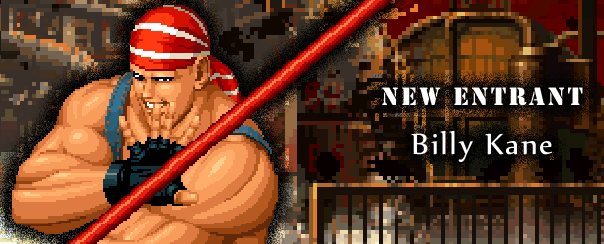
Billy Kane was the original King of Fighters champion in Fatal Fury before Terry Bogard. One of Geese’s reasons for reestablishing the King of Fighters tournament was to help train both Billy and Raiden: Geese’s personaly bodyguards. While Raiden gave up the position quickly Billy was and probably always will be Geese Howard’s right hand man. Billy was actually portrayed as something of a pussy in the original Fatal Fury. Billy’s very proficient with his splitting cudgel, but in the original game as soon as you knocked that cudgel out of his hands he turned into a whimpering loser.
Billy later evolved into more of a badass with a tougher attitude and better sense of fashion; but initially? You gotta wonder why Geese Howard chose him as a bodyguard. Some have said that Geese Howard found him on a trip to Billy’s birthplace England. Others claim he worked in one of Geese Howard’s factories and was found getting into a fight with a steel pipe. Either way: Considering Billy’s listed hobby is washing clothes and he’s noted as disliking dirty clothes, my guess is he used to work in a laundry prior to meeting Geese Howard. After Terry Bogard defeated Billy and knocked Geese off the tallest building in town it’s not really known how exactly Geese survived. Still Geese is revealed to live on and Billy continues to work as his main agent. Billy maintains a grudge against Terry Bogard, though it’s doubtful as strong as the one Geese has. A joke within the Fatal Fury series is that he likewise bears a grudge against Joe Higashi for making advances on his precious little sister Lilly. Lilly supposedly does not know of Billy’s criminal exploits, nor the real way that Billy supports her.
Geese sent Billy to the King of Fighters tournament on some sort of plan. Future trends would imply this plan was merely to investigate the goings on behind the King of Fighters tournament. In this case perhaps it was to discover how Rugal managed to survive the previous tournament or to examine the power of the fighters who defeated Rugal. An ulterior motive also seems to be getting some payback on the Fatal Fury Team, as Geese personally wrote the Lone Wolves a letter right before the tournament. Billy was tasked with creating a team to take to the tournament, eventually choosing both Eiji Kisaragi and Iori Yagami. Billy tempted the two with a chance to fight their rivals Ryo Sakazaki and Kyo Kusanagi. With that an extremely flimsy alliance was born along with the Rival Team.
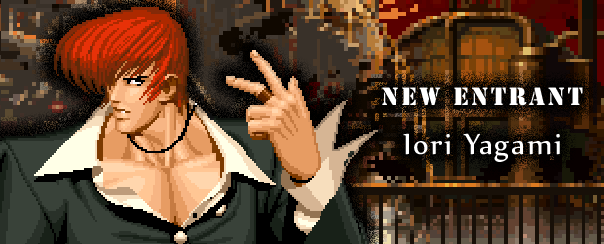
Iori Yagami is a mysterious new fighter with a similar power to Kyo Kusanagi’s. He has a nearly identical command of fire and somewhat similar fighting style, yet his flames are a strange purple tint. In various ways Iori is a polar opposite of Kyo. Probably the most obvious contrast between the two involves their clothing. While Kyo wears symbols of the sun, Iori wears symbols of the moon. The name Yagami even means “Night God” supposedly. One of the main focuses of King of Fighters 95 was to introduce Iori Yagami and establish him as a rival figure for Kyo Kusanagi. He starts out being quite the mystery, though he also appears to be from a famous clan. Like Kyo his name often precedes him in a fight. Even though not much is revealed about Iori in in KOF 95 his connection to myth is unmistakable. Like Kyo he has a Desperation Move referring to the Orochi legend. While Kyo has the Orochinagi or “Serpent Wave” attack, Iori has the Ya Otome or “Eight Madens.” When the move made its way overseas it became most commonly known as the Maiden Masher, referring to the sacrifices made to the Orochi in the form of young women. During location testing for the game Iori was possibly the most popular character with his intense personality and sense of style. His quotes were rude and his attacks where brutal.
What you mainly know about him from the get go is that he’s violent, has a grudge against Kyo Kusanagi, and he performs in rock bands. For those people that always complain about Iori’s ridiculous appearance: There you go. He’s a musician. I think he’s even based on the appearance of a real Japanese rock star who was popular at the time, but don’t quote me on that. If anyone could find Iori’s inspiration or correct me I’d be very appreciative. He was summoned indirectly by Billy Kane and given an invitation letter by one of Geese Howard’s personal assassins. Whether the assassin was just there to deliver a message or attacked Iori first I couldn’t say, but Iori promptly beat the assassin to death and dragged his corpse back to Billy. Iori would have attempted to burn both Billy Kane and Eiji Kisaragi to a crisp at their meeting place had Billy not invited him to the King of Fighters tournament. Knowing that Kyo Kusanagi would be there Iori accepts the invitation and makes it clear that he is absolutely not an ally.
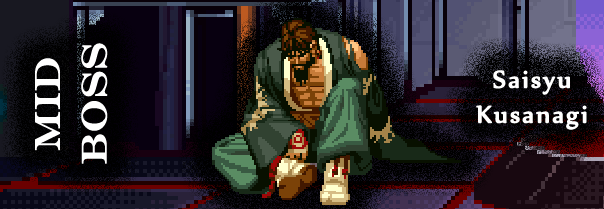
Kyo Kusanagi and the Japan Team once again win the King of Fighters tournament and are caught in a gas trap. Rugal then reveals himself to the team and provokes them by presenting Saisyu Kusanagi. Saisyu Kusanagi is Kyo Kusanagi’s father and the previous heir to the Kusanagi fighting style. As revealed if you play as Kyo’s team in the previous game Saisyu challenged Rugal at some point in 1994. Rugal managed to defeat him and had planned to keep him as a statue in his collection; but after losing to Kyo Kusanagi he changed his plans. Instead he held Saisyu hostage over the course of the year leading to King of Fighters 95 and instructed his secretaries to brain wash Saisyu. Saisyu is supposedly a wandering warrior constantly traveling the world. If so this would explain why Kyo never went searching for his father even after the explosion of the Black Noah. This little plot hole might have more to do with the fact SNK had originally intended for Saisyu to die in KOF 94.
Saisyu Kusanagi’s mental state is clearly not what it should be as Rugal Bernstein orders Saisyu to kill his son. Kyo’s team manages to defeat Saisyu and free him from his brainwashing and before losing consciousness Saisyu requests that his son kill Rugal once and for all. The scene is very similar to the one in King of Fighters ’94. Again with this game almost being a reboot of the series.
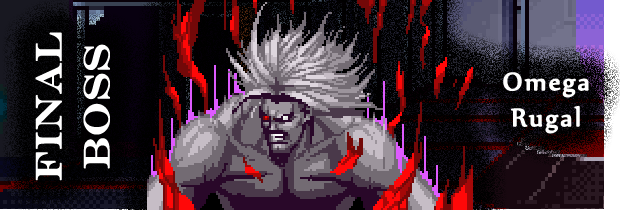
After officially being beaten by Kyo’s team in 1994, Rugal had supposedly committed suicide aboard the Black Noah. Very clearly he’s kicking in 1995 and he has upgrades. After Saisyu Kusanagi loses consciousness Rugal Bernstein makes his transformation into Omega Rugal. Rugal Bernstein has become a cyborg of all things. Channeling the same sort of unnatural power he’d been using before, Rugal’s sporting a mechanical hand and eye that seem to amplify his source of energy. He’s one of the most over-powered bosses you could possibly imagine. Saisyu is already a tough boss and you don’t get any breaks. Your health isn’t replenished and if you lose to Omega Rugal you have to start the entire fight with Saisyu over again. Trust me when I say it isn’t fair. Kyo’s team once again manages to defeat the obscenely powerful Omega Rugal. Before he can get his second wind Rugal is consumed by his own power and vanishes in a burst of evil energy. The image of a skull forms in the air as he disappears.
From this point on I should note that while only one team can win the tournament every year, every character seems to recall the events of the last game as if they were there. Because of that even if Kyo’s team has won both tournaments thus far we’re still going to assume the other teams were there to witness the events, or were at least nearby.
With Rugal Bernstein gone for good various characters make different observations. Saisyu Kusanagi has disappeared again, with fellow old man Takuma Sakazaki asserting that a fighter like Saisyu couldn’t possibly have died. Takuma Sakazaki then goes on to tell Ryo Sakazaki and Robert Garcia that he’s stepping down as head of the Kyokugen school, except that he’s still in charge and the only difference is Ryo and Robert will do all the fighting from now on. Ryo and Robert finally decide that fighting with Yuri Sakazaki might not be so bad. Heidern finally sees his family properly avenged for their deaths at Rugal’s hands, proclaiming that his wife and daughter can rest in peace. Heidern then tells Ralf Jones and Clark Still that Rugal was just a simple puppet. The Ikari team would have to fight again someday.
Kyo Kusanagi clearly recognizes the shade released from Rugal’s body before he disappeared, but he doesn’t tell Benimaru Nikaido or Goro Daimon just what it is. Saisyu is observing from a far distance, stating that Kyo can’t escape his fate as a Kusanagi. Yelling at seemingly nobody in particular Saisyu tells Kyo that he must train and grow stronger. Iori Yagami reveals that the power Rugal Bernstein was trying to use could only be truly controlled by those of a certain bloodline, after which Iori brutally beats Eiji Kisaragi and Billy Kane. Proving what he’d told the two previously about how his teammates were just his means to an end, Iori Yagami proclaims that Kyo Kusanagi is next on his hit list.
The Fatal Fury Team discusses what they’d just seen, wondering if some day they’ll have to fight a greater power than they ever have before. At the same time they decide it might not even have anything to do with them, as is common of the Fatal Fury team. Geese Howard proclaims from Geese Tower that he expected Billy to fail but next year Terry Bogard and the Lone Wolves would have to contend with him personally. Considering that Rugal Bernstein is dead you have to wonder how Geese knew another tournament was going to start, not unless Geese intended to revive the KOF tournament himself. The Psycho Soldiers team does their usual contemplation on the nature of evil and if there really is hope in the world. Same as the Fatal Fury Team they have a fairly standard routine with Chin Gentsai assuring them that there will always be good to fight evil.
Finally Mai Shiranui and Yuri Sakazaki get drunk in King’s bar, while Choi Bounge and Chang Koehan try to run away as soon as Kim Kaphwan mentions training for the next tournament. With that King of Fighters 1995 comes to its conclusion and a greater battle is yet to be seen in King of Fighters 1996.







My favorite part:
“Others claim he worked in one of Geese Howard?s factories and was found getting into a fight with a steel pipe.”
Hang in there buddy!
I guess that to get the right info from SNK you would have to work really hard. But, once you got all the pieces together, this makes a great story.
I’ve heard of it, yeah. There’s videos online floating around Youtube, for one of them at least. The live one. It’d be pretty fun to actually go see a Song of Fighters performance. As embarrassing as it would be to actually go to one of those it’s pretty cool how much fun SNK had when they had money.
The story of KOF is kind of nutty to understand, more so because SNK was a nutty company lol. What really catches my attention more are their KOF related side products, which are mostly impossibly rare. Have you heard of the NEO GEO DJ station?
Man, what I’d give to attend one of the KOF year end parties in Japan
I’m born in 87 but am a very late SNK fan. I wasn’t genuinely aware of King of Fighters until probably 2004. I’m just someone who has become a very big fan of them since that time. I really wish I had money back in SNK’s glory days to help support them, but since I can’t do that I’m just researching SNK’s past and creating the KOF Love Letter.
It’s my hope that someday there’ll be a second golden age of SNK that I can really be a part of. While I’m at it I really wish I could afford to buy a Neogeo arcade cabinet just for the sake of owning such a cool piece of history.
Wow quite nostalgic looking back. I’m guessing you were born somewhere in the 80’s? I’m an 88 kid, so when KOF 95 came out I never even thought I was going to understand it. I did manage to get it as a gift from a relative overseas though, which was sick.
It sucks witnessing the end of something great, especially when that’s the only thing you see. Oh well I think I should look for a Neo Geo on ebay or something